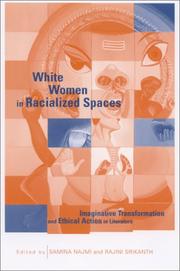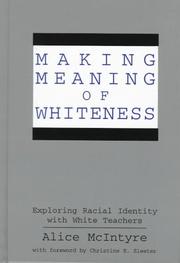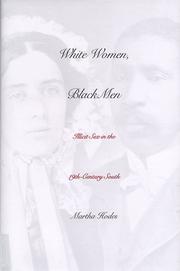| Listing 1 - 10 of 37 | << page >> |
Sort by
|

ISBN: 079148808X 9780791488089 9780791454787 0791454789 9780791454770 0791454770 0791454789 Year: 2002 Publisher: Albany State University of New York Press
Abstract | Keywords | Export | Availability | Bookmark
 Loading...
Loading...Choose an application
- Reference Manager
- EndNote
- RefWorks (Direct export to RefWorks)
Explores the unique relationship between white women and racial Others in a wide variety of literary works.
American literature --- Women, White, in literature. --- Women and literature --- Ethics in literature. --- Race in literature. --- Women, White. --- White women --- Literature --- White women in literature --- History and criticism.

ISBN: 080784232X 0807818089 0807864226 9780807864227 9780807818084 9780807842324 9798890865724 Year: 1988 Publisher: Chapel Hill London
Abstract | Keywords | Export | Availability | Bookmark
 Loading...
Loading...Choose an application
- Reference Manager
- EndNote
- RefWorks (Direct export to RefWorks)
Discusses how class, race, and gender shaped women's experiences in the South.
Women --- Southern States --- History --- Plantation life --- Slavery --- African American women --- Women, White --- White women --- Afro-American women --- Women, African American --- Women, Negro --- History. --- Race relations

ISBN: 058505584X 9780585055848 9780791434963 0791434966 9780791434956 0791434958 0791434958 0791434966 1438412495 9781438412498 Year: 1997 Publisher: Albany
Abstract | Keywords | Export | Availability | Bookmark
 Loading...
Loading...Choose an application
- Reference Manager
- EndNote
- RefWorks (Direct export to RefWorks)
Teachers, White --- Student teachers --- Women teachers, White --- Race awareness --- Discrimination in education --- Multicultural education --- White women teachers --- Preservice teachers --- Teachers --- White teachers --- Attitudes. --- Women teachers --- Attitudes
Book
ISBN: 0817390685 9780817390686 9780817319342 0817319344 Year: 2017 Publisher: Tuscaloosa The University of Alabama Press
Abstract | Keywords | Export | Availability | Bookmark
 Loading...
Loading...Choose an application
- Reference Manager
- EndNote
- RefWorks (Direct export to RefWorks)
Women, White --- White women --- Social life and customs --- Findley, Annie Earline Moore, --- Tuscaloosa (Ala.) --- University (Ala.) --- Tuskaloosa (Ala.) --- Race relations --- History
Book
ISBN: 146964097X 1469640988 9781469640983 9781469640976 9781469640952 1469640953 9781469640969 1469640961 9798890854292 Year: 2018 Publisher: Chapel Hill
Abstract | Keywords | Export | Availability | Bookmark
 Loading...
Loading...Choose an application
- Reference Manager
- EndNote
- RefWorks (Direct export to RefWorks)
Delving into wartime diaries kept by women of the southern slave-owning class, Steven Stowe recaptures their motivations to keep the days close even as war tore apart the brutal system of slavery that had benefited them. In studying the inner lives of these unsympathetic characters, Stowe also explores the importance - and the limits - of historical empathy as a condition for knowing the past.
Slaveholders --- Women, White --- White women --- Slave holders --- Slave masters --- Slave owners --- Slavemasters --- Slaveowners --- Persons --- Plantation owners --- Slavery --- Diaries. --- United States --- History --- Historiography. --- Women. --- Enslavers
Book
ISBN: 1681236494 9781681236490 9781681236476 1681236486 9781681236483 1681236478 Year: 2017 Publisher: Charlotte, N.C.
Abstract | Keywords | Export | Availability | Bookmark
 Loading...
Loading...Choose an application
- Reference Manager
- EndNote
- RefWorks (Direct export to RefWorks)
Historically, white women have had a tremendous influence on establishing the ideological, political, and cultural scaffold of American public schools. Pedagogical orientations, school policies, and classroom practices are underwritten by white, cisgender, feminine, and middle to upper class social and cultural norms. Labor trends suggest that students of color are likely to sit in front of many more white women teachers than males or non?white teachers, thus making it imperative to better understand the nature of white women's work in culturally diverse settings and the factors that most profoundly impact their effectiveness. This book examines how white women teacher dispositions (i.e. knowledge, beliefs, and skills) intersect (and/or interact) with their racial identity development, the concept of whiteness, institutional racism, and cultural perspectives of racial difference. All of which, as the authors in this volume argue, matter for nurturing a teaching practice that leads to more equitable schooling outcomes for youth of color. While it is imperative that the field of education recruits and retains more nonwhite teachers, it is equally important to identify research?supported professional development resources for a white woman?dominated profession. To that end, the book's contributors present critical insight for creating cultural contexts for learning conducive to effective cross?cultural and cross?racial teaching. Chapters in the first section explore white women's role in establishing and maintaining school environments that cater to Eurocentric sensibilities and white racial preferences for learning and social interaction. Authors in the second section discern the implications of white images, whiteness, and white racial identity formation for preparing and professionally developing white women teachers to be effective educators. Chapters in the third section of the book emphasize the centrality of race in negotiating academic interactions that demonstrate culturally responsive teaching. Each chapter in this book is written to investigate the intersectionality of race, cultural responsive pedagogies, and teaching identities as it relate to teaching in multi-ethnic environments. In addition, the book offers solution?oriented practices to equip white women (and any other reader) to respond appropriately and adequately to the needs of racially diverse students in American schools.
Women teachers, White --- Multicultural education --- Whites --- Sexism in education --- Race awareness --- White women teachers --- Race identity --- White persons --- Ethnology --- Caucasian race --- White people
Book
ISBN: 9781474430319 9781474430326 1474430317 1474430325 9781474430296 1474430295 1474453600 9781474453608 Year: 2019 Publisher: Edinburgh : Edinburgh University Press,
Abstract | Keywords | Export | Availability | Bookmark
 Loading...
Loading...Choose an application
- Reference Manager
- EndNote
- RefWorks (Direct export to RefWorks)
In the first extended study into the politics of whiteness inherent within postfeminist cinema, Kendra Marston interrogates representations of melancholic white femininity in contemporary Hollywood cinema, arguing that the 'melancholic white woman' serves as a vehicle through which to explore the excesses of late capitalism and a crisis of faith in the American dream. This figure may be idealised or scapegoated within these films, yet strategic performances of gendered melancholia may produce benefits for white female directors and stars disadvantaged within a patriarchal industry. Examining film genres including the tourist romance, the fantasy film and the psychological thriller, the book also contains case studies of films like 'The Virgin Suicides,' 'Blue Jasmine,' 'Gone Girl' and 'The Girl on the Train.'
Book
ISBN: 9780252080302 9780252038730 9780252096686 0252096681 0252038738 0252080300 1322191166 Year: 2014 Publisher: Urbana
Abstract | Keywords | Export | Availability | Bookmark
 Loading...
Loading...Choose an application
- Reference Manager
- EndNote
- RefWorks (Direct export to RefWorks)
The death of Princess Diana unleashed an international outpouring of grief, love, and press attention virtually unprecedented in history. Yet the exhaustive effort to link an upper class white British woman with 'the people' raises questions. What narrative of white femininity transformed Diana into a simultaneous signifier of a national and global popular? What ideologies did the narrative tap into to transform her into an idealised woman of the millennium? Why would a similar idealisation not have appeared around a non-white, non-Western, or immigrant woman? Raka Shome investigates the factors that led to this defining cultural/political moment and unravels just what the Diana phenomenon represented for comprehending the relation between white femininity and the nation in postcolonial Britain and its connection to other white female celebrity figures in the millennium.
Social stratification --- Sociology of the family. Sociology of sexuality --- Sociology of culture --- Diana [Princess of Wales] --- United Kingdom --- Diana, Princess of Wales, 1961-1997 --- Popular culture --- National characteristics, British --- Women, White --- White women --- History. --- History --- Social conditions. --- Diana, --- Spencer, Diana Frances, --- Di, --- Dayānā, --- In mass media. --- Influence. --- Princess Diana, --- Lady Di, --- Dynasty Di,

ISBN: 0300069707 0300173679 0585371954 9780300173673 9780585371955 9780300069709 Year: 1997 Publisher: New Haven Yale University Press
Abstract | Keywords | Export | Availability | Bookmark
 Loading...
Loading...Choose an application
- Reference Manager
- EndNote
- RefWorks (Direct export to RefWorks)
This book is the first to explore the history of a powerful category of illicit sex in America's past: liaisons between Southern white women and black men. Martha Hodes tells a series of stories about such liaisons in the years before the Civil War, explores the complex ways in which white Southerners tolerated them in the slave South, and shows how and why these responses changed with emancipation.Hodes provides details of the wedding of a white servant-woman and a slave man in 1681, an antebellum rape accusation that uncovered a relationship between an unmarried white woman and a slave, and a divorce plea from a white farmer based on an adulterous affair between his wife and a neighborhood slave. Drawing on sources that include courtroom testimony, legislative petitions, pardon pleas, and congressional testimony, she presents the voices of the authorities, eyewitnesses, and the transgressors themselves-and these voices seem to say that in the slave South, whites were not overwhelmingly concerned about such liaisons, beyond the racial and legal status of the children that were produced. Only with the advent of black freedom did the issue move beyond neighborhood dramas and into the arena of politics, becoming a much more serious taboo than it had ever been before. Hodes gives vivid examples of the violence that followed the upheaval of war, when black men and white women were targeted by the Ku Klux Klan and unprecedented white rage and terrorism against such liaisons began to erupt. An era of terror and lynchings was inaugurated, and the legacy of these sexual politics lingered well into the twentieth century.
Sex role --- Sex customs --- Women, White --- African American men --- History --- Sexual behavior --- Sexual behavior. --- United States --- Social conditions --- Afro-American men --- Men, African American --- White women --- Customs, Sex --- Human beings --- Sexual practices --- Southern States --- Men --- Manners and customs --- Moral conditions --- Sex --- Confederate States of America --- 19th century --- Civil War, 1861-1865 --- To 1865 --- Lost Cause mythology
Book
ISBN: 0813031834 9780813031835 Year: 2003 Publisher: Gainesville University Press of Florida
Abstract | Keywords | Export | Availability | Bookmark
 Loading...
Loading...Choose an application
- Reference Manager
- EndNote
- RefWorks (Direct export to RefWorks)
''A pioneering book . . . original in its arguments, thorough in its presentation of the complex contexts of the white woman writer in Africa, and sophisticated in its set of readings and in its combination of biography, social history, and criticism.
Women and literature --- Authors, South African --- Authors, Danish --- Women, White --- White women --- History --- Schreiner, Olive, --- Dinesen, Isak, --- דינסן, איסק, --- Andrézel, Pierre, --- Blixen, Karen, --- Blixen, Tania, --- Osceola, --- Iron, Ralph, --- Sharīnara, Āliwa, --- Āliwa Sharīnara, --- Shrēyner, Ō., --- שריינער, אליוו, --- שרײנער, אליװ, --- Cronwright-Schreiner, Olive, --- Knowledge --- Africa. --- Africa --- Intellectual life --- In literature.
| Listing 1 - 10 of 37 | << page >> |
Sort by
|

 Search
Search Feedback
Feedback About UniCat
About UniCat  Help
Help News
News